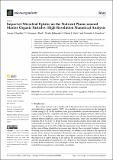Impact of Microbial Uptake on the Nutrient Plume around Marine Organic Particles: High-Resolution Numerical Analysis
Author(s)
Kapellos, George E.; Eberl, Hermann J.; Kalogerakis, Nicolas; Doyle, Patrick S.; Paraskeva, Christakis A.
Downloadmicroorganisms-10-02020.pdf (6.236Mb)
Publisher with Creative Commons License
Publisher with Creative Commons License
Creative Commons Attribution
Terms of use
Metadata
Show full item recordAbstract
The interactions between marine bacteria and particulate matter play a pivotal role in the biogeochemical cycles of carbon and associated inorganic elements in the oceans. Eutrophic plumes typically form around nutrient-releasing particles and host intense bacterial activities. However, the potential of bacteria to reshape the nutrient plumes remains largely unexplored. We present a high-resolution numerical analysis for the impacts of nutrient uptake by free-living bacteria on the pattern of dissolution around slow-moving particles. At the single-particle level, the nutrient field is parameterized by the Péclet and Damköhler numbers (<i>0 < Pe < 1000</i>, <i>0 < Da < 10</i>) that quantify the relative contribution of advection, diffusion and uptake to nutrient transport. In spite of reducing the extent of the nutrient plume in the wake of the particle, bacterial uptake enhances the rates of particle dissolution and nutrient depletion. These effects are amplified when the uptake timescale is shorter than the plume lifetime (<i>Pe/Da < 100</i>, <i>Da > 0.0001</i>), while otherwise they are suppressed by advection or diffusion. Our analysis suggests that the quenching of eutrophic plumes is significant for individual phytoplankton cells, as well as marine aggregates with sizes ranging from 0.1 mm to 10 mm and sinking velocities up to 40 m per day. This microscale process has a large potential impact on microbial growth dynamics and nutrient cycling in marine ecosystems.
Date issued
2022-10-13Department
Massachusetts Institute of Technology. Department of Chemical EngineeringPublisher
Multidisciplinary Digital Publishing Institute
Citation
Microorganisms 10 (10): 2020 (2022)
Version: Final published version